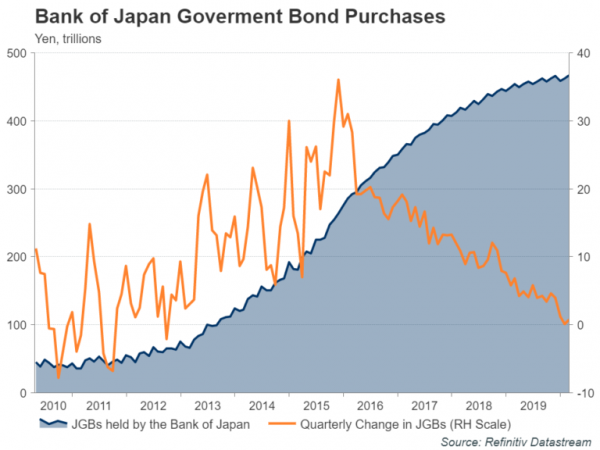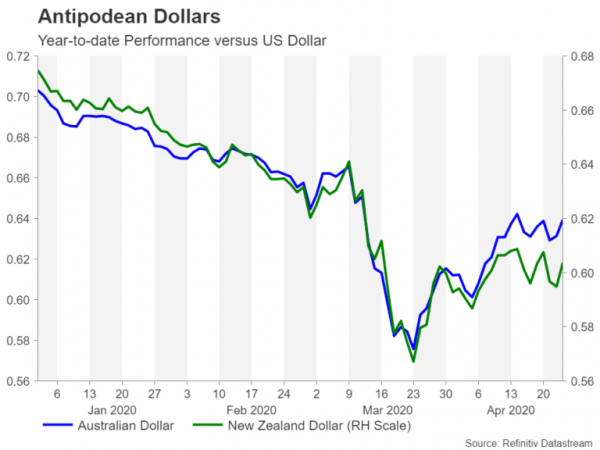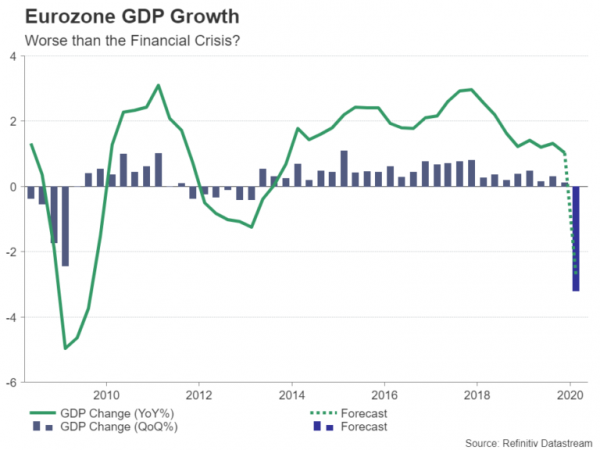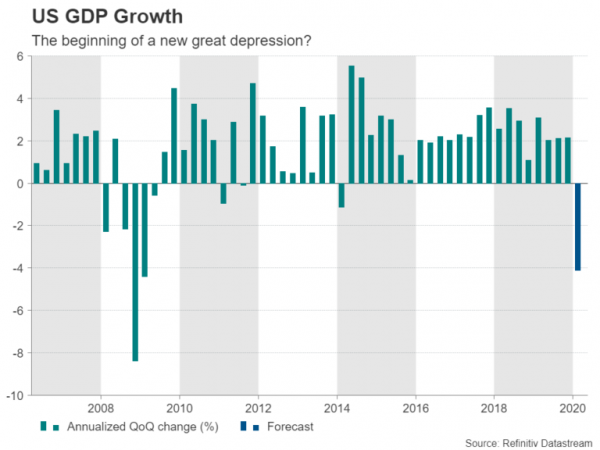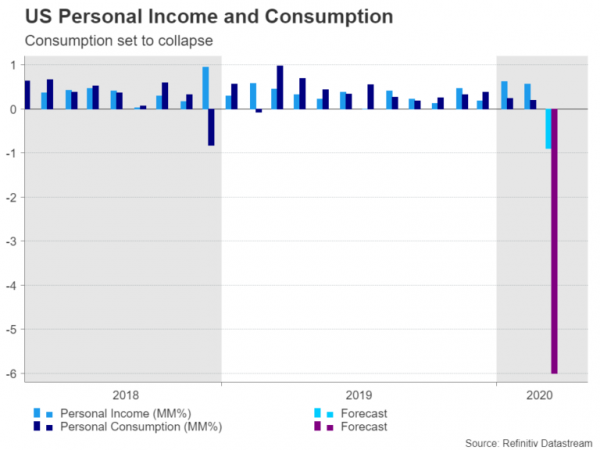It’s been a hectic couple of months for central banks around the world as most have held at least one unscheduled meeting as the virus crisis unfolded. Hence, next week’s regular gatherings by the Federal Reserve, European Central Bank and the Bank of Japan may not bring anything new, as aside from the interim meetings, policymakers have also been keeping the communications channels wide open and so the possibility of major surprises appears slim. Nevertheless, markets may need the soothing words of policymakers to fall back on if flash GDP readings from the Eurozone and the United States spark fresh jitters about growth.
Bank of Japan may be one to watch
The Bank of Japan joined its peers by beefing up its stimulus program when it met on March 16 for an emergency meeting. According to media reports, the BoJ is poised to go further into unchartered territory when it meets on Monday by removing the cap on the amount of government bonds it can purchase and by doubling the amount of commercial paper and corporate bonds it buys. With interest rates just below zero and not expected to go any lower due to concerns about the side-effects of negative rates, asset purchases are the only tool the BoJ has to fight the virus pandemic.
Next week will also see the release of some important data as preliminary industrial output and retail sales numbers for March are due on Thursday. The figures are predicted to be almost as dismal as those seen so far in other countries such as the United States even though the Japanese government had decided against strict shutdowns like those enforced in Europe. But Japan is now experiencing a second wave of COVID-19 cases in some regions, prompting the government to declare a nationwide state of emergency. That means the data can only get worse in the coming months, especially as Japanese exporters, already bruised from the Sino-US trade war, will struggle to sell their goods in an environment where demand has collapsed globally.
But as far as the yen is concerned, risk sentiment will remain its main driver, with any ‘surprises’ from the BoJ unlikely to produce anything other than knee-jerk reactions.
Virus containment propels aussie higher
Another country where businesses are not facing severe lockdowns is China, where the virus outbreak peaked in February and many restrictions have since been relaxed. But as with Japan, the dire situation elsewhere means exporters will not benefit, and domestically, consumption is not anticipated to bounce back to the levels enjoyed prior to the crisis anytime soon. Thus, the official manufacturing and non-manufacturing PMIs out of China on Thursday may not do much in lifting risk appetite even if they continue to recover in April, as there can be no doubt about the bleak outlook in the near term.
However, a subdued response to any upbeat Chinese data in the broader markets may not necessarily apply to the Australian dollar. The aussie – often traded as a liquid proxy for the Chinese yuan – got a double boost in the past week. First, signs that Australia is succeeding in containing the coronavirus reinforced views that the lockdown will be eased soon, and second, an unexpected jump in preliminary retail sales figures in March raised hopes that the country can avoid recession.
The aussie is therefore likely to overreact to any positive market developments, though as far as domestic data is concerned, there’s nothing too exciting on the agenda. First quarter inflation numbers might attract some attention on Wednesday, while quarterly export and import prices due on Thursday may provide an indication as to the contribution of net trade on GDP.
Across the Tasman Sea, the ANZ business outlook survey for April out on Thursday is a possible risk for the kiwi to be alert about. The New Zealand dollar is in a similar position to the aussie as New Zealand is also doing a better job than Europe or the US in keeping the virus under wraps. But with the Reserve Bank of New Zealand pondering whether to take rates to negative territory, the kiwi may be unable to sustain positive momentum if incoming data point to the need for more stimulus.
Eurozone GDP to go into freefall; will ECB come to the rescue?
The euro slipped to a one-month low this week as horrendous preliminary PMI numbers flashed warning signs about the damage to the Eurozone economy from the virus pandemic. Fears of economic destruction will be realized further on Thursday when the flash GDP report is published. The Eurozone economy is expected to have contracted by a staggering 3.2% on a quarterly basis in the first three months of the year as the continent went into lockdown. That would point to a steeper recession than the 2008-09 financial crisis!
Other data to watch include the Economic Sentiment Indicator on Wednesday and flash inflation figures on Thursday.
However, the euro will probably be more preoccupied with the worrying widening in Eurozone bond yield spreads amid concerns about rising debt levels, as well as on the European Central Bank’s policy meeting on Thursday. Concerns about the ability of highly indebted nations such as Italy in being able to spend their way out of this crisis have led to a spike in periphery yields in recent days and unless EU leaders are able to agree to a massive relief fund where member states share the burden of at least some of the debt, the euro will likely continue to be pressured.
For now, though, moves by the ECB to accept junk bonds as collateral, which opens the way for the bank to keep buying Italian government bonds should they get downgraded to junk status, has alleviated the immediate panic. The single currency should also find support from any additional measures that the ECB may announce next week to ease the market stress and maintain plenty of liquidity. Ultimately, however, it will be up to EU politicians to calm investor nerves on the issue of whether Europe is well equipped to recover from the virus fallout.
Fed to sit tight as US economy set to shrink
The Fed has already thrown everything including the kitchen sink at the US economy in a desperate bid to avoid total catastrophe as the deadly coronavirus has forced most businesses to go into hibernation. That has left the Fed with very few new options and policymakers are expected to sit tight when they meet on Tuesday and Wednesday for their first regular meeting since January.
But markets will nevertheless still be interested in what the Fed has to say as the Federal Open Market Committee’s (FOMC) updated economic projections will be published. They will coincide with the advance GDP report for the first quarter, which is expected to show the economy shrinking at an annualized quarterly rate of 4.1%.
The GDP print will be accompanied by a flurry of other releases in the US next week. The Conference Board consumer confidence index for April is out on Tuesday, pending home sales are due on Wednesday, personal income and consumption are released on Thursday along with the PCE inflation figures for March, and the latest ISM manufacturing PMI will be eyed on Friday.
Gloomy FOMC forecasts and depressing GDP numbers have the potential to cause fresh angst among investors about the future prospects for the world’s largest economy. However, if risk sentiment is dampened by the data and the Fed’s forecasts, the US dollar will likely continue to act as a safe haven and gain in the currency markets, inflicting fresh downside pressure on its rivals such as the euro and the pound.




